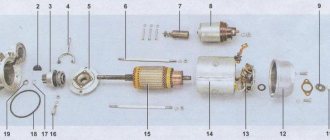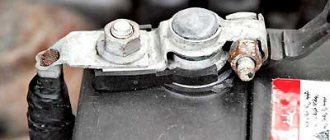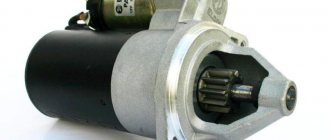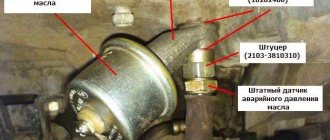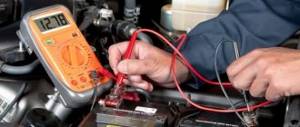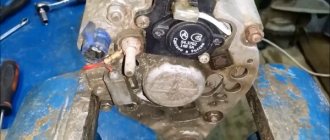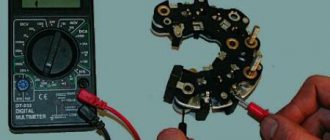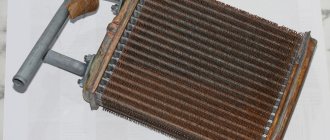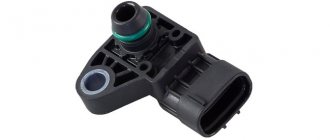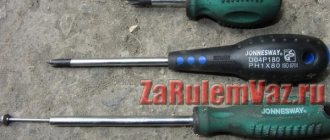Starter retractor relay VAZ 2106
Many people have probably found themselves in a situation where their car for some unknown reason did not want to start.
If everything is normal with the electronics, the battery is working properly and charged, then the problem is probably in the starter. If subsequent attempts to start the engine fail, then it’s time to get ready for repairs. The bottom line is that the starter is not complicated in structure, and with instructions, any motorist can disassemble and reassemble it. However, even with such a simple design, removing and then installing the solenoid relay turns out to be very problematic for many. The first step is to diagnose the part and identify the location of the breakdown. The first thing a mechanic notices is the ignition switch and the power relay, located under the hood of the car.
If the starter is silent when starting the engine, then most likely the breakdown lies in these parts. If at the moment of starting the starter rattles, clicks, or makes noise, then the source of the breakdown is located in another place.
Just in case, check the battery again and replace it if necessary. If after replacement the problem does not disappear, then you will have to proceed with more serious repairs.
Repair
What to do if the starter and solenoid relay do not turn on.
First of all, we check the charging of the battery and recharge it if necessary. Next, you need to check the condition of the battery terminals, check their tightness and, if necessary, clean them from oxidation.
There is a break in the wire from the additional relay to the solenoid relay, check and, if necessary, fix the problem.
The contact board of the ignition switch has failed, as a result of which the lock does not supply voltage to the power supply circuit of the starter and traction relay.
The holding coil of the solenoid relay has lost contact with ground or it has become unreliable.
The solenoid relay is turned on, but the starter armature does not rotate.
Again, you must first check the charging of the battery, also check the condition of the battery terminals, if necessary, clean them and tighten them.
The malfunction may also be hidden in the traction relay itself, namely, the starter contacts could have burned out.
Remove the starter from the car and check the condition of the brushes and brush holders, replace the brushes if necessary.
As a result of the “spacing” of the winding, the starter armature is jammed and therefore, when the solenoid relay is turned on, it does not turn.
The solenoid relay turns on and off - knocking.
Again, first of all, when determining a malfunction, we look for a possible cause in the battery, check its charging and the quality of the connection of the terminals and their condition. We eliminate all defects and if the retractor does not work as it should, then we continue to look for the fault further.
The holding coil of the solenoid relay has lost reliable contact with ground.
The reversing lights do not light up on the link.
How to remove
Next, we need a minimum of tools, namely:
Screwdriver with a flat blade 13 socket with a wrench or ratchet (open-end or socket wrench)
First of all, unscrew the nut securing the terminal leading from the starter to the relay:
Then we bend the terminal to the side so that it does not interfere with us:
Now take a screwdriver and unscrew the two bolts securing the solenoid relay.
After which you can remove this part, slightly lifting it up to free it from the clutch with the starter.
What is the price
Depending on the manufacturer and store. From 400 to 900 rubles.
Where is
— As far as I remember, under the hood on the right, near the air filter. There are three relays, two nearby - low beam, high beam and the third starter relay
— Power to the starter solenoid relay comes from the ignition switch (cl. 50 thick red wire)
Starter repair
Having determined the possible malfunction and its cause, as well as having prepared the tool and removing the starter from the machine, you can begin to repair the device.
Disassembly
When disassembling the starter, care should be taken not to lose small parts, of which there are quite a lot in the device.
It is customary to begin disassembling the starter by removing the solenoid relay. This can be done as follows: disconnect the wires - the output of the starter windings. Using a 13mm wrench, you need to unscrew the fastening nut and remove the wire, as well as the washers. After this, you need to unscrew the three screws from below that hold the solenoid relay in place. The relay can be pulled out, and after that we pull out the armature of the retractor relay by removing the spring and pushing it slightly up and to the side.
Now you need to remove the top protection. It is necessary to unscrew the 2 screws securing the protection casing and remove it. The next step requires the use of screwdrivers, with which you need to pick up the locking ring of the rotor shaft and remove it with the washer together.
Check for short to body. If you don’t know how to do this, ask any electrician. Using a 10mm wrench, you need to unscrew the two bolts securing the cover from the housing, and then use a screwdriver to unscrew the screws securing the connecting wire and the starter winding wire.
Separate the body and cover of the device, remove the brushes with springs by prying them off with a screwdriver. Take a pre-prepared bearing mandrel and press out the rear starter bearing. Everything should be done carefully so as not to break the case. Pull out the cotter pin using a screwdriver and pliers, and then remove the rubber plug and the anchor with the fork. Press out the second bearing. Remove the bendix - the gear that engages the flywheel. To do this, you need to move the washer and use screwdrivers to remove the retaining ring.
Be careful - the retaining ring sometimes flies off in an unknown direction, so you need to substitute something.
Remove the bendix with a slight movement of your hand and you will get a completely disassembled starter.
Starter solenoid relay
The design of the relay in the starter of a VAZ 2106 car is considered to be quite simple, and every even slightly enthusiastic motorist can easily disassemble and assemble it independently. However, removing and then reinstalling the solenoid relay turns out to be an impossible task for many. However, professionals can handle this without difficulty.
If you suspect that the solenoid relay in your car is broken, you should definitely check it. The relay in the VAZ 2106, as in other car models, works as an electromagnet. In order to check its serviceability, you need to close it with a metal object, for example, a screwdriver. If the starter starts to rotate, then the fault is indeed in the relay. If you hear clicks from the retractor relay, but the starter does not start to rotate, then you need to look for the breakdown in it itself.
Why might the starter relay stop functioning? There may be several reasons. Firstly, materials can deteriorate due to age. Secondly, the winding may burn out. And finally, thirdly, the nickels inside the relay itself can burn out.
Checking the starter without removing it
Consider a situation where you are on the road and the garage is very far away. How to check the starter for performance in this case?
Let's consider several verification options.
To begin, take a metal object (for example, a screwdriver with a bare shaft or a piece of wire) and jumper the terminals on the starter:
- Check the battery terminals for oxidation. If the appearance of plaque is noticeable, then clean it with fine-grained sandpaper or, in extreme cases, a knife;
- change the starter relay (very often it is this that causes such problems);
- make sure there is a continuity between the starter relay and the device itself (the wiring may be damaged).
2. The starter rotates the crankshaft, but very weakly:
- Charge the battery (perhaps this is the reason). If this happens on the road, then “light up” from another car (you can stop a driver passing by);
- Make sure that the power wires that go to the starter are intact.
3. You turn the key in the ignition, but instead of turning the crankshaft normally, you hear clicks. The reasons may be as follows:
- the battery is discharged;
- poor quality of contacts that fit to the starter (make sure all connections are intact and tighten the contacts).
If all else fails, then the likely cause is a broken solenoid relay.
4. The ignition switch does not work. If the checks do not produce results, then we can assume that the lock itself is faulty. To exclude this version, it is necessary to clean all contact connections that go to the lock.
Starter relay repair
Repairing the starter relay seems to be a very troublesome and often hopeless task, so an easier option would be to simply buy a new one and replace it. This is due to the fact that, worrying about the reliability of their product, most manufacturers produce non-separable starter relays for both VAZ 2106 cars and other brands of cars. However, there are still models that are not difficult to disassemble and repair.
There are several main breakdowns that you may encounter while working with the starter relay of a VAZ 2106 car. The first is wear of the mechanical wire, the second is the burning of nickels, and the third is a short circuit. Each of these failures can be determined by disassembling the starter relay.
You can also use a special tester to check the serviceability of the starter relay, which does a good job of determining a short circuit in the circuit.
If, after disassembling this part, you find scratches or burrs on it, they need to be removed using sandpaper. Parts that have significant wear can be corrected using gaskets, but this does not always bring the desired result. Sometimes it will be more effective to replace them with new ones. Damaged insulation should also be replaced with a new one. Collectors with worn or loose plates cannot be repaired and must be replaced.
If there are noticeable breaks or damage to the thread, then it is worth cutting a new one or using so-called screws.
If there are faults in the excitation windings, you should disassemble the housing, remove the screws securing the tips and terminals. The coils must be thoroughly dried and impregnated with insulating varnish. Contacts that have oxidized must be cleaned, and those that have been welded must be replaced with new ones.
The bushings on the starter of a VAZ 2106 car are changed if they have significant wear or scuff marks are found on them. To determine the wear of these same bushings, you need to measure the roller clearance. If it is more than 0.2 mm, then the bushings are worn out and must be replaced.
Assembling the starter parts of a VAZ 2106 car is carried out in the reverse order to the one in which you disassembled it.
When carrying out all the above work, one should not forget about safety precautions and under no circumstances violate them.
VESKO-TRANS.RU
AutoNews / Reviews / Tests
- Home
- Auto garage
- Where is the Starter Relay on the VAZ 2106
Where is the Starter Relay on the VAZ 2106
Checking and repairing the starter electromagnetic relay
Many people have apparently had to find themselves in a situation where their car, for unknown reasons, did not want to start. If the electronics are fine and the battery is working and charging, then it looks like the problem is with the starter. If the next attempt to start the engine fails, then it’s time to prepare for repairs.
The bottom line is that the starter is not complex in design, and if there is an abstract, then at least some motorist will be able to disassemble and reassemble it. But even with this conventional design, removing and reinstalling the electromagnetic relay turns out to be very problematic for many.
VESKO-TRANS.RU
AutoNews / Reviews / Tests
Where is the Starter Relay on the VAZ 2106
Checking and repairing the starter electromagnetic relay
Many people have apparently had to find themselves in a situation where their car, for unknown reasons, did not want to start. If the electronics are fine and the battery is working and charging, then it looks like the problem is with the starter. If the next attempt to start the engine fails, then it’s time to prepare for repairs.
The bottom line is that the starter is not complex in design, and if there is an abstract, then at least some motorist will be able to disassemble and reassemble it. But even with this conventional design, removing and reinstalling the electromagnetic relay turns out to be very problematic for many.
First you need to diagnose the part and determine the location of the failure. The mechanic's eyes were the first to catch the ignition switch and relay under the hood of the car.
If the starter is silent when you start the engine, there is probably a breakdown in these places. If at the moment of starting the starter roars, clicks, noises, then the center of the breakdown is located in a different place.
So, just in case, check the battery and replace it if necessary. If the problem persists after replacement, a more complex repair will be required.
Car starter: main purpose
Sooner or later, every car owner, regardless of its make and model, has to face the problem that his vehicle refuses to start. The first thing, naturally, is to check the fuel level, battery charge, and electronics. If all this does not cause any complaints and doubts about serviceability, then most likely the problem is in the starter. After all, successful engine starting depends on it.
Currently, as a rule, relays 35.3708 with an end-mounted collector are installed on cars of this model.
However, on some copies of the VAZ 2106, starters made in Germany or Belarus may be installed, since they can be interchanged with starter 35.3708.
At an earlier time, approximately in the 70-80s, the ST-221 starter was also installed.
Causes and symptoms of malfunction
Let's look at certain signs of starter failure and figure out what can lead to its failure in each specific case.
If, when you turn the key in the ignition, the starter does not show signs of life, the problem may be a dead battery or a non-functioning starter.
If the electronics of the car are working properly, but it does not start, the problem is in the starter. It is possible that the contacts inside the solenoid relay have become stuck and stopped working.
Some people encounter this phenomenon when the starter turns over, but the engine does not start. The malfunction may be due to wear on the device brushes.
Another sign is when when you turn the key in the lock, a click is heard and nothing else happens. This is the cause of the solenoid relay malfunction.
When you try to start the power unit, multiple clicks are heard from under the hood - this is a sign of Bendix failure. This is the name of the gear responsible for engagement with the flywheel.
If the starter jams, this is a serious problem, sometimes associated with wear on the starter shaft or housing. This leads to misalignment, as a result of which the teeth begin to jam.
There is another malfunction associated with bearing wear. They are inexpensive, but to replace the device you have to disassemble
We have listed some of the main VAZ 2106 starter faults that motorists encounter. If any of these problems are detected, it becomes clear that the VAZ starter needs to be repaired as soon as possible.
Starter solenoid relay
The design of the relay in the starter of a VAZ 2106 car is considered to be quite simple, and every even slightly enthusiastic motorist can easily disassemble and assemble it independently. However, removing and then reinstalling the solenoid relay turns out to be an impossible task for many. However, professionals can handle this without difficulty.
If you suspect that the solenoid relay in your car is broken, you should definitely check it. The relay in the VAZ 2106, as in other car models, works as an electromagnet. In order to check its serviceability, you need to close it with a metal object, for example, a screwdriver. If the starter starts to rotate, then the fault is indeed in the relay. If you hear clicks from the retractor relay, but the starter does not start to rotate, then you need to look for the breakdown in it itself.
Why might the starter relay stop functioning? There may be several reasons. Firstly, materials can deteriorate due to age. Secondly, the winding may burn out. And finally, thirdly, the nickels inside the relay itself can burn out.
Checking the starter without removing it
Consider a situation where you are on the road and the garage is very far away. How to check the starter for performance in this case?
Let's consider several verification options.
To begin, take a metal object (for example, a screwdriver with a bare shaft or a piece of wire) and jumper the terminals on the starter:
- Check the battery terminals for oxidation. If the appearance of plaque is noticeable, then clean it with fine-grained sandpaper or, in extreme cases, a knife;
- change the starter relay (very often it is this that causes such problems);
- make sure there is a continuity between the starter relay and the device itself (the wiring may be damaged).
2. The starter rotates the crankshaft, but very weakly:
- Charge the battery (perhaps this is the reason). If this happens on the road, then “light up” from another car (you can stop a driver passing by);
- Make sure that the power wires that go to the starter are intact.
3. You turn the key in the ignition, but instead of turning the crankshaft normally, you hear clicks. The reasons may be as follows:
- the battery is discharged;
- poor quality of contacts that fit to the starter (make sure all connections are intact and tighten the contacts).
If all else fails, then the likely cause is a broken solenoid relay.
4. The ignition switch does not work. If the checks do not produce results, then we can assume that the lock itself is faulty. To exclude this version, it is necessary to clean all contact connections that go to the lock.
